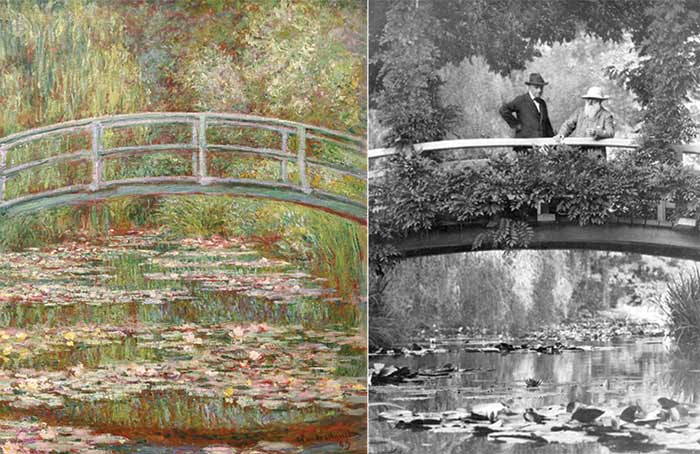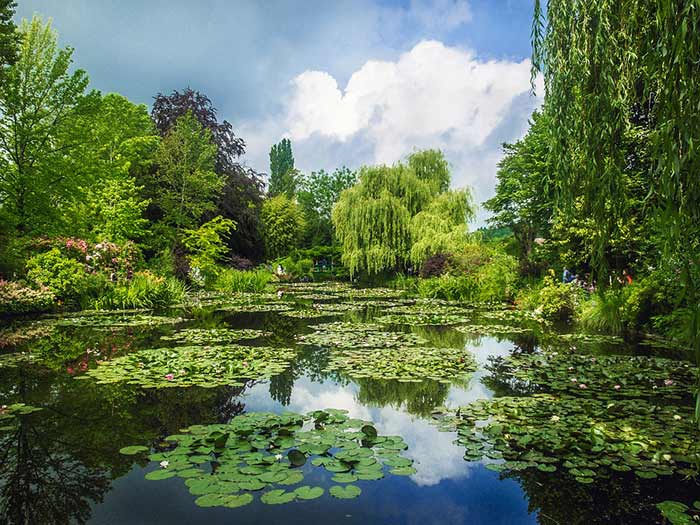Part 2: Jardin d’Eau
Article by Mies Šmes
In 1893, Monet was able to acquire the adjacent land to his property at Giverny (which was separated by the railway), where he gave life to an extravagant oriental water garden. For this lush project, not only he had to divert water from a branch of the Epte river, but he also had to stand against his neighbors, as they did not want the water to be contaminated by his exotic plants. Still, in the end, Monet got away with it and was permitted to carry out his plan. Inspired by the Japanese prints he avidly collected —his two hundred and thirty one Japanese woodblock prints are currently exhibited in the house—, he designed a green wooden footbridge over an artificial pond, surrounded by wisteria vines, bamboo, irisis and different varieties of newly bred water lilies.

Left: Monet, Claude. Bridge over a Pond of Water Lilies, 1899
Right: Monet and his friend Georges Clémenceau, with whom he shared his passion for Japan, art and exotic plants
While at the beginning Monet and his family had taken care of the place themselves, after expanding it and having the resources for hiring full time gardeners (seven of them in total), the painter continued to be in charge of the constant redesigning of the garden, giving daily instructions to his gardeners staff, such as having his beloved water lilies cleaned every morning from the train soot they collected.
Precisely, as the garden was not only intended ‘for the pleasure of the eye’ but ‘also for motifs to paint’ as he said, it was there he found the inspiration for his Japanese Bridge and Nymphéas (‘Water Lilies’) series —comprising almost 250 works of art. Monet, keen on portraying the same subject under different lighting and weather conditions, painted over and over his water lilies, sometimes using large-scaled canvases so that the viewer would feel immersed in his garden in spite of not being physically there. The sky reflected on the water and the algae moving at the bottom of the pond were ‘a wonderful sight, but it drives one to crazy to try to paint it’. Another obstacle were the cataracts he had developed in both eyes, that may have influenced his last years’ painting style.

Left: Monet, Claude. Water Lilies, 1905
Center: Monet, Claude. White and Yellow Water Lilies, 1915-1917
Right: Monet, Claude. Water Lilies, 1922
After World War I, Monet donated some of the large-scaled water lilies paintings to the Musée de l’Orangerie —with his friend Georges Clémenceau, who also happened to be the Prime Minister of France at that time, acting as an intermediary. The eight panels —measuring nearly 328 linear feet— arranged in two oval rooms (forming an infinite symbol) according to the painter’s design, first exhibited a few months after his death in 1926. The oval rooms can be now visited virtually.
Upon Monet’s death in 1924, his son Michel inherited the property, but as he did not have any interest in living there, Alice Hoschedé’s daughter, Blanche —who was also Jean Monet’s widow— took care of both the house and the garden. Since she was a child, Blanche had been interested in art, taking lessons from Monet and visiting the studio of Impressionist artist Édouard Manet. During all those years in Giverny, she had been his step-father’s only student and assistant, often portraying the same subjects with the same palette —it is suspected she also helped him paint some details of the Water Lilies series. After her death, the place fell into oblivion.

Left: Monet, Claude. Haystack, Morning Snow Effect, 1891
Right: Hoschedé-Monet, Blanche. Haystack, Effect of Snow, 1891
It would not be until after Michel’s death in 1966 that efforts were made for the place to look like Monet had intended it to. Almost ten years of restoration later —guided by a gardener who had worked alongside Monet, friends that had visited the house in its days of glory, and black and white photographs— a team of horticulturists could painstakingly bring back to life the colorful gardens. Both the neglected bridge and pond had to be redone completely, although the wisterias surrounding them are still the ones planted by Monet. The garden opened to the public in 1980, and it has been visited by all those who wish to feel inside a Monet painting (but end up being interrupted by tourists taking pictures) ever since.

Monet’s garden at Giverny in 1980

Monet’s oriental water garden at present day





What a lovely article – it felt like I was in the garden with Monet. Then felt the desolation of the neglect after Alice died. And, now the garden has been lovingly and painstakingly been restored to Monet’s original intent.
I really enjoyed this little journey. Thank you.